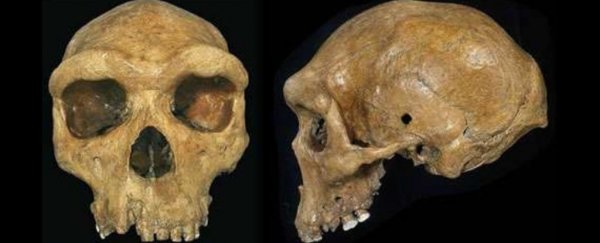The Broken Hill skull has long been considered one of the key hominin fossils found in Africa, a possible relative of modern humans. It was recovered from cave deposits in what is now Zambia almost a century ago, and to this day, it remains one of the best-preserved skulls of a fossil hominin ever discovered.
In all that time, no one's been able to figure from whence this early human actually came. The original site has since been destroyed, and while the remains are often said to be as much as 500,000 years old, their exact age has been somewhat contentious.
Using radiometric dating methods directly on the skull, researchers have now come up with the most precise estimate yet, putting the remains at 300,000 years old, give or take approximately 25,000 years.
It would mean that this particular human ancestor - called either Homo rhodesiensis or H. heidelbergensis - lived among a diverse company of other hominins. At one point, they may have even been our neighbours.
"Therefore," the authors write, "just as Eurasia in the later Middle Pleistocene contained the multiple evolving lineages of H. neanderthalensis, Denisovans, H. floresiensis, H. luzonensis and perhaps also H. heidelbergensis and H. erectus, different human lineages and/or species also co-existed across Africa."
Along with H. heidelbergensis/H. rhodesiensis, this also includes the recently identified H. naledi and early H. sapiens.
Previous assessments have placed the Broken Hill skull with surrounding artefacts and fauna in the late Pleistocene.
"Our re-analyses of the macro- and microfauna were inconclusive," the research team writes in their new study, noting that any of the small animal bones found in the same sediment could have been deposited at a different time.
While most of the sediment was loosely attached to the skull and the eye sockets empty, it's not clear if this was how the skull was found in 1921.
"We need to emphasise that apart from the sediment and the small mammals that were collected from around and within the skull, none of the materials collected from the Broken Hill site can unequivocally be connected to the depositional history of the skull," the authors write, "nor can we think of an additional dating analysis to independently verify our results."
Instead, the new dates rely primarily on uranium isotopes in the soil, skull and teeth, as well as smaller mammal bones found inside and outside the skull.
These small fragments were determined to be of different ages, with different geochemical environments from that of the skull. So the sediment-covered skull either occurred after the microfauna developed, or the microfauna must have been incorporated later.
"To conclude, we cannot be sure that the sediment in which the skull was found was actually associated with the skull for any considerable period of its burial history," the researchers write.
"The only directly associated sediment remnant that we could find after several years of searching was retained."
Using sediment scraped off the skull, the researchers used a combined uranium-series and electron spin resonance calculation. The results revealed an upper age limit of 322 thousand years.
"Only extreme scenarios would allow older age estimates," they conclude.
If verified, the implications of this new age estimate will be major. Placing this particular hominin fossil later in time means stone artefacts found in the Middle Stone Ages may not have been ours after all.
"We can no longer assume that only H. sapiens produced stone tools assigned to the African Middle Stone Age," the team writes.
It also suggests that in Africa, human evolution may not have been quite as gradual, ranging from archaic humans such as the Broken Hill skull all the way to modern humans.
Alternatively, the human evolution scenario in Africa could have involved considerable skeletal variation just 300,000 years ago - a story that's consistent with the idea H. sapiens evolution really was pan-African, taking place through intermittent genetic connections between diverse populations of early humans.
"Hence, late-surviving populations of H. heidelbergensis/H. rhodesiensis could have been a source of 'ghost' introgressions" the authors write.
In light of their new findings, the authors argue we must reconsider the supposed status of H. heidelbergensis as an ancestor of modern humans.
It is, after all, supposed to be an intermediate between H. sapiens and Neanderthals; the authors argue its facial evolution "does not represent the most parsimonious last common ancestor."
The study was published in Nature.
